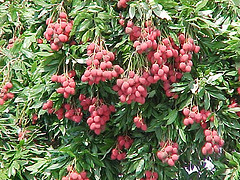Litchis
| Infobox on Litchis | |
|---|---|
| Example of Litchis |  |
| Freshness facts | |
| Optimum carrying temperature | 2°C |
| Highest freezing point | - |
| Acceptable product temp. at loading into containers | Max. 2°C above carrying temperature |
| Optimum humidity | 90%-95% |
| Ventilation setting for containers | 10 m³/hr |
| Storage life | 4-6 weeks |
| Climacteric / non-climacteric | Non-climacteric |
| Ethylene production | Medium |
| Ethylene sensitivity | Medium |
| Modified / controlled atmosphere | 3%-5% CO2; 3%-5% O2 |
| Potential benefits | Low O2 can reduce skin browning and polyphenoloxidase activity. Elevated CO2 slows the loss of ascorbic acid, acidity and soluble solids |
| Availability | |
| Australia Madagascar South Africa C. America |
October - February November - January November - March March - May |
Litchis
Contents
Harvesting and handling
Litchis, also spelled lychees, originated in southern China where they have been cultivated for at least 2000 years. The round to egg-shaped fruit, about 2,5 cm in diameter, has a thin leathery red skin which has blunt or sharp spines. The edible, translucent-opaque flesh (aril) encloses a large, occasional small, black seed.
Litchis do not show an increase in respiration when exposed to ethylene, and appear to be non-climacteric. Hence they must be allowed to mature fully on the tree. Although the flesh of the litchi evolves very little ethylene, the peel, on the other hand, produces substantial amounts of it. Related to this is the phenomenon of physiological browning, the most important disorder of harvested litchis. Unless preventative measures are taken, litchis can lose their fresh red colour within a day or so of harvest. Internal quality is unaffected, but the market value is much reduced. Browning involves the formation of dark substances which are produced in response to injury or desiccation. Darkening, desiccation and decay limit the storage life of fresh litchis.
Skin colour and fruit size are external quality criteria. Internal criteria are seed size and flesh sweetness/juiciness. A bright red fruit with no browning is preferred along with freedom from bird, insect, and mechanical damage, cracking and decay.
Cooling and storage
Different selections and cultivars of two main types of litchis are produced in the sub-tropical areas of South Africa. Fruit of Mauritius type can be stored at a lower (2°C) temperature than fruit of the Madras types (4°C). Best commercial results are, however, obtained by storing both types at +2°C. The main reason for this is that litchis are extremely susceptible to mould growth, which can be fairly effectively suppressed by the lower temperature. This mould growth develops on the stem end and even in minute cracks that may form on the outer skin. The fruit must be kept dry and handled very carefully at all times. Litchis are (often) treated with sulphur dioxide (SO2) to reduce mould growth.
The SO2 also softens and bleaches the skin to a more attractive light brown colour. Although most of the SO2 is bound in the outer hard skin, the fruit may still give off SO2 during transport. Litchis should therefore not be stowed with other produce. SO2 treatment may induce undesirable aftertaste and is not approved for use on litchis marketed in the U.S.A.
At the ideal storage temperature, litchis have a PSL of approx. 3-5 weeks. Retention of water by good packaging and rapid cooling (after harvest) is likely to show the best results. Ethylene removal may, in some cases, retard ripening and reduce respiration. A breakdown (softening, loss of turgidity) of flesh occurs in senescent fruit after prolonged storage and over-maturity. The condition starts at the blossom end. Field and sometimes postharvest skin cracking can occur.
Litchis have low sensitivity to chilling temperatures. However, dehydration during storage often leads to loss of skin colour and browning and is referred to as chilling injury.
Mixed loads
Not to be stowed with other produce (in view of SO2 treatment).
Cautions
Litchis are very sensitive to moisture loss and should be kept in a high humidity environment.
Storage disorders
Aspergillus rot, Chilling injury, Physiological browning, Sour rot, Yeasty rot.











